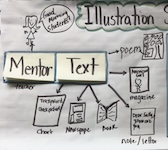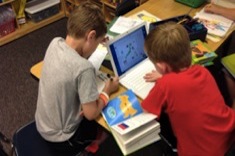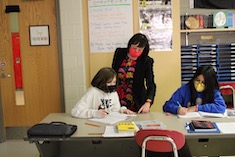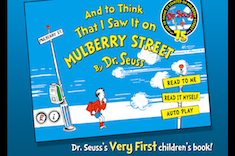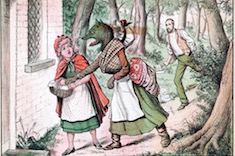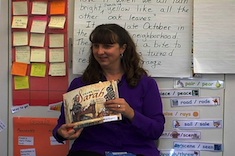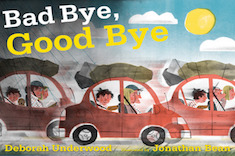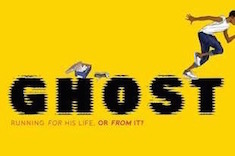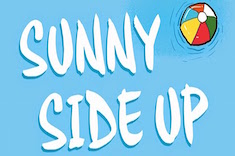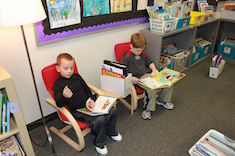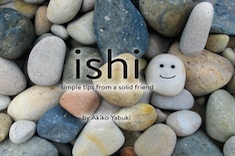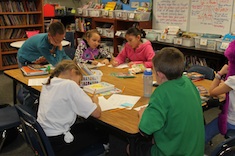Mentor Texts
It's all about the right book at the right time, given to the right student or used in the right lesson . . . Here is where we gather all those suggestions from our contributors for using mentor texts, including lesson protocols and scores of video examples.
Latest Content
Mentor Texts Elevate Readers and Writers
Bitsy Parks uses mentor texts to elevate her students as writers. Although mentor texts are included in many curriculum programs, Bitsy offers more opportunities for students to use mentor texts to strengthen their reading and writing lives.
I Was Wrong About…
Gretchen Schroeder invited her students to write personal essays inspired by the 2022 New York Times series “I Was Wrong About.” Gretchen shared with her students (and now shares with us) the way she was wrong about her mammy collection.
Graphic Engagement
Joanne Emery supports students as readers and writers of graphic novels. Included is a list of resource books and websites, as well as students’ favorite graphic novels.
Letting Informational Mentors Lead the Way
Tara Barnett and Kate Mills share a practical process for using an informational mentor text to support students as readers and writers. Download a note sheet to support students in noticing text structure.
Age Poems
Katherine Sokolowski immerses students in poetry with mentor texts about age and time to linger in thinking about their own ages. This combination invites poetry into classrooms and gives students space to embrace the genre by writing their own age poems.
What Criteria Should We Use When Selecting Whole-Class Texts?
Christy Rush-Levine reminds us that text selection affects students. By shaping a unit of study to contain texts of varying formats and representing a wide variety of characters, students are empowered to develop their own ideas even while reading a whole-class text. Download a diverse text list to deepen a discussion of how family shapes identity.
Craft Moves in Before the Ever After
Melanie Meehan unlocks a few craft moves in Before the Ever After by Jacqueline Woodson.
Overplayed Mentor Texts
Bitsy Parks outlines how to select mentor texts in order to have more ownership over the lesson and engage students.
Scaffolding Instruction in an Author Study
Christy Rush-Levine scaffolds her middle-school students’ understanding of craft moves by moving from short stories to novels when studying specific authors.
When Learning Gets Tricky, Go Back to the Pigs
Whenever a tricky literary concept comes up, Tammy Mulligan finds herself returning to a favorite mentor text to guide students. She explains the value of shared simple stories for understanding complicated literary elements.
Crafting the Basics: First-Grade Writing Conference
Bitsy Parks confers with Aubrey early in the year, using books from whole-class lessons as a scaffold for understanding key text elements like title, author, and illustrations.
Bringing Multiple Texts and Perspectives into Teaching Point of View
Katherine Sokolowski finds her students are struggling to understand point of view. She takes a detour over a week with mentor texts, quick assists from favorite writers on Twitter, and practice sessions retelling Little Red Riding Hood to teach the concept.
Fourth-Grade Minilesson: Character Traits
Gigi McAllister helps her fourth graders develop the characters in their writing with a minilesson. She uses three mentor texts, one of which is her own writing.
End-of-Year Read Alouds
Bitsy Parks explains how the ending weeks of read alouds in her first-grade classroom are designed to celebrate learning and shared experiences from the entire year.
Using Mentor Texts Across the Writing Process
Tara Barnett and Kate Mills describe how they use one mentor text, Owl Moon, to teach multiple lessons on craft during a writing unit.
Mentor Texts for Letter Writing
Clare Landrigan and Tammy Mulligan share some of their favorite mentor texts for a unit on letter writing.
Great Books for African American Boys
Shari Frost deals with the failure of a classic read-aloud text to reach young African American boys by finding more engaging books for them.
Giving Graphic Organizers a Go
Mary Lee Hahn is skeptical about how her fifth-grade students might use graphic organizers. But once she tries them alongside students, she begins to see their utility.
Building Community with a Shared Text
Christy Rush-Levine finds a community of new teachers bonds over a text highlighting addiction struggles. The experience leads her to think through what elements are essential for whole-class texts in her middle school classroom.
Using Stories to Launch Writers’ Notebooks
If you're looking for the perfect launch for writers' notebooks this school year, you might want to begin with story. Tara Barnett and Kate Mills explain how.
Building Relationships with Authors
Katie DiCesare is helping her students move from mentor texts to seeing authors as mentors through their websites and other digital resources.
Mentor Texts and Important Reminders
Melanie Meehan shares four important tips for using mentor texts effectively with students of any age.
Get in the Pool: Teachers Who Write
Ruth Ayres shares how she was always someone who wrote—until she became a teacher. Getting back into writing was all about motivating her reluctant students.
Using Paired Texts with Beginning Readers
Shari Frost explains how teachers can use paired texts to help young readers build their skills, starting with books they already know and love.
Replicating or Deepening?
Jennifer Schwanke finds teachers can get territorial about texts, “claiming” them for their grade level. She explores when it is appropriate to repeat the use of a text in subsequent grades.
Opening the Year with Optimism
Katrina Edwards shares her plans for presenting children’s literature to help her first-grade students acquire the skills they need to be positive and proactive problem solvers.
Using Mentor Texts to Craft Leads
Tara Barnett and Kate Mills carefully select the first mentor text for crafting leads in their fourth-grade classroom.
Mentors for Process and Habits
Ruth Ayres shares some of her favorite mentors and mentor texts for developing good writing processes and habits.
From Mentor Texts to Mentors in First Grade
Katie DiCesare uses technology in her first-grade classroom so that students can see the lives of the authors who create the texts they love.
Mentor Texts for Crafting Nonfiction
Melanie Meehan talks with a third-grade teacher about how she helps students focus on craft elements in nonfiction mentor texts.
Browse Content By
Type
Category
- Assessment Tools
- Big Fresh Archives
- Booklists
- Choice Numeracy
- Classroom Design
- Common Core
- Community Building
- Conferring
- Content Literacy
- Digital Literacy
- English Language Learners
- Equity
- Family Relations
- Free Samples
- Guiding Groups
- Leadership
- Literacy Coaches
- Mentor Texts
- Minilessons
- New Teacher Mentors
- Podcasts
- Poetry
- Quote Collections
- Reading Strategies
- Self Care
- Struggling and Striving Learners
- Talking and Listening
- Teacher Study Groups
- Teaching Reading
- Teaching Writing
- Word Study and Vocabulary
Author
- Melissa Quimby
- Nawal Qarooni
- Gwen Blumberg
- Julie Cox
- The Lead Learners
- Hannah Tills
- Josie Stewart
- Ruth Metcalfe
- Mallory Messenger
- Becca Burk
- Jodie Bailey
- Vivian Chen
- Mary Brower
- Tiffany Abbott Fuller
- Stephanie Affinito
- Ruth Ayres
- Leigh Anne Eck
- Heather Fisher
- Shari Frost
- Julie Johnson
- Suzy Kaback
- Gigi McAllister
- Shirl McPhillips
- Melanie Meehan
- Cathy Mere
- Debbie Miller
- Tara Barnett and Kate Mills
- Tammy Mulligan
- Dana Murphy
- Bitsy Parks
- David Pittman
- Brenda Power
- Heather Rader
- Matt Renwick
- Mandy Robek
- Christy Rush-Levine
- Gretchen Schroeder
- Jen Schwanke
- Brian Sepe
- Katherine Sokolowski
- Stella Villalba
- Jennifer Vincent
Grade Level
Choice Literacy Membership
Articles
Get full access to all Choice Literacy article content
Videos
Get full access to all Choice Literacy video content
Courses
Access Choice Literacy course curriculum and training

